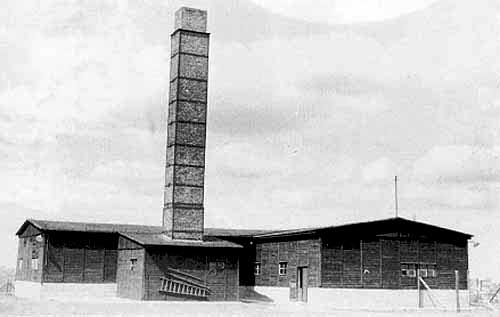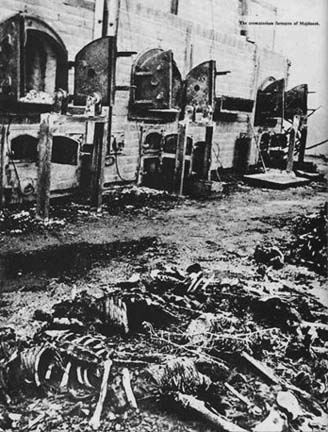Crematorium at Majdanek The photograph above shows the ovens in the Majdanek crematorium, on the side away from the entrance door, with the metal stretchers which were used to shove the bodies inside. The original wooden crematorium building at Majdanek was burned by the Nazis on July 22, 1944, just before they abandoned the camp, but the ovens remained intact. The reconstructed crematorium, which is open to tourists, is located at the top of a long slope, behind the spot where the barracks in Field V once stood. This is a reconstruction of the second crematorium that was built in the camp, which was not in operation until the autumn of 1943, according to the Museum guidebook. When the camp first opened, the bodies were buried in mass graves, but from June 1942 on, there were burned in the first crematorium, or on pyres made from the chassis of old lorries (trucks), according to the guidebook. The first crematorium is no longer in existence, and I never learned the exact location of it. It had two ovens which were brought to Majdanek from the Sachsenhausen camp in Germany. The new crematorium was outfitted with five Kori ovens which were fueled with coke. As you first walk into the crematorium, you see the row of five ovens. They are placed so close to the entrance door that you realize that there would not have been enough room for workers to slide the bodies inside. Then you walk around to the other side and see that the bodies were put into the ovens from the back side and the ashes taken out on the front side, a few feet from the entrance door. You can look all the way through the ovens and see that the interior of each oven is long enough to accommodate two bodies, placed end to end. On the front side, you can see ashes still remaining in the ovens. The movie shown at the Visitor's Center showed bones still in the ovens when the camp was liberated, although they have since been removed.  According to Martin Gilbert in his book "Holocaust Journey," there is a gas chamber in this crematorium building which, like the building, is a reconstruction. Since it is a reconstruction, this gas chamber room does not show the blue staining that is present in the other gas chambers at Majdanek. The gas chamber room in the crematorium is very small; it has a hole in the ceiling for pouring in the poison gas crystals, and there is a floor drain directly below the hole. The door to this gas chamber is missing, and may have been taken to another museum for display. A casting of a Majdanek gas chamber door is on display at the United States Holocaust Museum in Washington, D.C. Right next to the room which has the 5 ovens, there is an alcove, or room open on one side, which has a large concrete bathtub. According to the guide, this tub was used by the SS man in charge of the ovens. In the shower room adjacent to the other gas chambers at Majdanek, there are two similar concrete bathtubs where the prisoners were dipped into disinfectant before taking a shower. The reconstructed gas chamber in the crematorium resembles a shower room.  The black and white photo above shows the ruined crematorium as it looked when Russian soldiers arrived at the camp on July 23, 1944. The wooden crematorium building had been set on fire by the Nazis in order to burn the bodies of Polish political prisoners who had been brought from the Gestapo prison at the Castle in Lublin and executed the day before liberation. Their charred remains are shown in the foreground in the photo. In the background are the brick ovens with iron doors which were not damaged in the fire. The main gas chamber building, which is located down the slope at the other end of the camp, was not burned, leaving behind ample evidence of the Nazi crimes. In another room of the crematorium building is the concrete dissection table, on which the bodies were examined for valuables hidden in body cavities, according to the tour guide. It was here also that the gold teeth were removed from the victims after they were gassed. After the camp was liberated, bones of the cremated victims were gathered and put on display in a glass case, according to accounts written by visitors to Majdanek. I didn't see any glass case, but there was a large closed casket on display in the crematorium. The casket was covered with funeral wreaths, bouquets of flowers and candles left by visitors. The tour guide pointed out a new memorial plaque, placed at the crematorium in 1998, which had upgraded the percentage of Jewish victims in the Majdanek camp to 48%. The former number was 41%, which is mentioned in the guidebook. During the Communist regime in Poland, the suffering of the Jews was downgraded and the martyrdom of the Poles was emphasized. Now that is slowing changing to reflect the greater suffering by the Jews. Of the remaining victims, 31% were Polish political prisoners, 16% were POWs from the USSR and 5% were POWs or political prisoners from 26 other countries, according to the Museum booklet. Although most of the prisoners were either Jewish or Christian, there were also a few political prisoners in the camp who were Muslims or Buddhists, according to the Museum booklet. Outside the crematorium building, there was a real rose garden or "Rosenfeld" with miniature roses planted in two beds on either side of the path when I visited in October 1998; one of the flower beds had a clashing border of orange marigolds. LiberationHistoryTourGas ChamberBack to Majdanek indexHome |